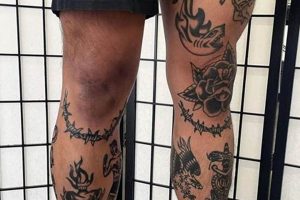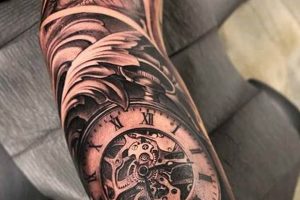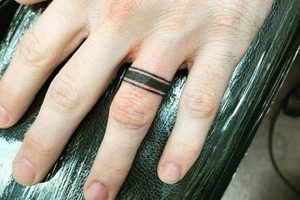Patriotic or nationalistic body art designs constitute a popular choice for men seeking to express cultural pride, heritage, or affinity for a specific nation. These designs often incorporate national symbols, flags, maps, or iconic imagery associated with a particular country. For example, an American eagle, a Canadian maple leaf, or a Japanese rising sun could be central elements in such tattoos.
Representing a powerful statement of identity and belonging, these emblems can serve as permanent reminders of one’s roots or adopted homeland. Historically, such markings have signified group affiliation, warrior status, or spiritual beliefs. In contemporary society, they continue to carry personal meaning, reflecting individual values and connections. The permanence of tattoos adds significance, transforming these symbols into lifelong declarations.
This exploration will delve into various design options, including stylistic choices like traditional, realistic, and minimalist approaches. Considerations such as placement on the body and the symbolism associated with specific national emblems will also be examined.
Tips for Choosing Country-Themed Tattoos
Careful consideration should be given to several factors before committing to a permanent display of national pride. The following tips offer guidance for selecting meaningful and aesthetically pleasing designs.
Tip 1: Research Symbolism: Thoroughly investigate the historical and cultural significance of chosen symbols. Certain imagery can hold unintended meanings or be associated with controversial historical events.
Tip 2: Consider Placement: Tattoo size and intricacy should inform placement decisions. Larger, more detailed designs may be better suited for larger areas like the back or chest, while smaller, simpler emblems can be placed on the forearm or bicep.
Tip 3: Choose a Reputable Artist: Selecting a skilled and experienced tattoo artist specializing in the desired style is crucial for achieving a high-quality, lasting result. Review portfolios and seek recommendations to ensure artistic compatibility.
Tip 4: Explore Different Styles: Consider various artistic styles, such as traditional, realistic, watercolor, or minimalist, to determine the aesthetic that best reflects personal preferences and complements the chosen imagery.
Tip 5: Reflect on Personal Meaning: The most impactful tattoos hold deep personal significance. Reflect on the connection to the chosen country and select imagery that resonates with individual experiences and values.
Tip 6: Plan for Long-Term Care: Tattoos require ongoing care to maintain vibrancy and prevent fading. Commit to proper aftercare procedures and sun protection to preserve the design’s integrity over time.
Tip 7: Consult with the Artist: Open communication with the chosen artist is essential. Discuss design ideas, placement options, and any concerns to ensure a collaborative and satisfactory outcome.
By adhering to these guidelines, individuals can ensure their chosen designs are well-executed, meaningful representations of national pride, and sources of lasting personal satisfaction.
With these considerations in mind, one can confidently embark on the journey of selecting a tattoo that serves as a powerful and enduring emblem of national identity.
1. National Symbols
National symbols represent a core component of patriotic tattoo designs, offering powerful visual shorthand for expressing national identity. These symbols, deeply embedded in cultural heritage, encapsulate shared values, history, and national pride. Their inclusion in body art transforms personal statements into public declarations of belonging and allegiance. For example, the American bald eagle, embodying freedom and strength, becomes a potent emblem when inked onto skin, communicating a profound connection to American ideals.
The selection of specific national symbols carries significant weight. A Welsh dragon evokes mythical strength and national pride, while the Scottish thistle symbolizes resilience and defiance. The choice reflects not only national affiliation but also personal resonance with the symbol’s historical and cultural significance. Understanding the nuances of these symbols is crucial for ensuring the tattoo accurately conveys the intended message. A rising sun, while evocative of Japan, can also carry negative connotations depending on historical interpretations and cultural sensitivities.
Careful consideration of symbolism, cultural context, and personal meaning ensures the chosen emblem resonates authentically and avoids unintended misinterpretations. By understanding the profound connection between national symbols and identity, individuals can select powerful and enduring designs that express their patriotism with depth and integrity.
2. Flags
Flags, potent emblems of national identity, hold significant weight within the realm of patriotic tattoos. Their inclusion serves as a direct and unmistakable declaration of national affiliation, transforming a personal canvas into a statement of belonging. The visual impact of a flag, with its distinct colors and design, immediately communicates allegiance and pride. A waving American flag, for instance, instantly conveys a deep connection to the United States, its history, and its values. Similarly, the Union Jack, with its intricate combination of crosses, acts as a powerful symbol of British heritage and identity.
The choice of flag design often extends beyond simple national affiliation. Historical flags, such as a specific wartime banner or a revolutionary flag, can represent a deeper connection to a particular historical period or ideology. This adds layers of meaning to the tattoo, transforming it into a tribute to a specific era or a statement about historical significance. Furthermore, the stylistic representation of the flag offers additional opportunities for personalization. A tattered flag can symbolize resilience and enduring patriotism, while a waving flag suggests dynamism and national pride. The inclusion of other elements, such as an eagle perched atop an American flag, further enhances the symbolic meaning and visual impact.
Ultimately, the inclusion of flags in patriotic tattoos represents a powerful and enduring expression of national identity. The choice of flag, its design, and its stylistic representation combine to create a unique and deeply personal statement of belonging and allegiance. Careful consideration of these elements ensures the tattoo accurately and effectively communicates the intended message of national pride and connection.
3. Landmarks
Landmarks, as prominent features of geographical landscapes, serve as powerful representations of national identity within the context of patriotic tattoos. Incorporating iconic structures or natural formations provides a visual connection to a specific country, transforming the body into a living canvas that reflects geographical and cultural heritage. The Eiffel Tower, immediately recognizable as a symbol of France, becomes more than just a tourist attraction; it embodies French history, artistry, and national pride when rendered as a tattoo. Similarly, Mount Fuji, revered in Japanese culture, can represent a deep connection to Japan’s natural beauty and spiritual traditions when chosen as a tattoo design.
The selection of specific landmarks offers opportunities for personalized storytelling within the broader narrative of national identity. The Statue of Liberty, for instance, can represent not only American ideals but also the personal journey of immigration and the pursuit of freedom. The Great Wall of China, etched onto skin, can symbolize strength, resilience, and a connection to ancient history and cultural heritage. These choices reflect not just national affiliation but also individual experiences and values, adding layers of meaning to the tattoo. Furthermore, the artistic style in which the landmark is depicted can further personalize the design. A minimalist outline of the Colosseum can evoke a sense of timeless classicism, while a realistic rendering of a local landmark can represent a deep connection to a specific region or community.
Incorporating landmarks into patriotic tattoos allows for a nuanced expression of national pride, combining geographical representation with personal meaning. This approach transforms simple depictions of place into powerful statements of identity, belonging, and connection to one’s chosen country. The permanence of the tattoo underscores the enduring significance of these landmarks in shaping individual and collective narratives of national identity.
4. Wildlife
Wildlife, intrinsically linked to specific geographical locations, offers a rich source of imagery for patriotic tattoos, allowing individuals to express national pride through representations of native fauna. These animal emblems often carry cultural significance, symbolizing national characteristics, historical narratives, or environmental values. A bear, emblematic of Russia’s strength and wilderness, can become a powerful symbol of national identity when incorporated into a tattoo. Similarly, the kangaroo, uniquely associated with Australia, represents a distinct connection to the continent’s unique biodiversity and cultural heritage. These choices move beyond simple depictions of animals; they embody national narratives and individual connections to the natural world.
The selection of specific wildlife reflects not only national affiliation but also personal values and beliefs. A bald eagle, soaring across an American flag, can represent freedom, strength, and a commitment to national ideals. A majestic lion, symbolic of England’s regal history, can evoke a sense of heritage and national pride. Furthermore, the artistic style employed can further personalize the tattoo’s meaning. A realistic rendering of a kiwi bird can highlight New Zealand’s unique fauna, while a stylized depiction of a Chinese dragon can represent mythical power and cultural heritage. These choices offer opportunities for nuanced storytelling within the broader context of national identity.
By incorporating native wildlife, individuals can create powerful and evocative tattoos that celebrate national pride while also reflecting personal values and connections to the natural world. The permanence of these designs underscores the enduring significance of wildlife in shaping both individual and collective narratives of national identity. This approach transforms simple depictions of animals into powerful symbols of belonging, heritage, and connection to a specific place and its unique ecological identity.
5. Cultural Motifs
Cultural motifs, symbolic designs deeply embedded within a nation’s heritage, offer a rich tapestry of imagery for patriotic tattoos. These motifs, often drawn from folklore, art, religion, or historical traditions, provide a nuanced and layered approach to expressing national identity. Their incorporation into tattoo designs transforms personal statements into powerful expressions of cultural pride and connection to ancestral heritage.
- Traditional Patterns and Designs
Traditional patterns and designs, such as Celtic knots (Ireland), Maori T moko (New Zealand), or Nordic runes (Scandinavia), represent a visual language deeply connected to cultural heritage. These intricate designs, often passed down through generations, carry symbolic meaning related to ancestry, spirituality, or national identity. Incorporating these patterns into tattoos allows individuals to connect with their ancestral roots and express a profound sense of cultural belonging. The complexity and artistry of these designs also create visually striking tattoos that serve as powerful statements of cultural pride.
- Symbolic Objects and Artifacts
Symbolic objects and artifacts, such as dreamcatchers (Native American cultures), kokopelli figures (Southwestern Native American cultures), or samurai helmets (Japan), represent tangible connections to cultural heritage. These objects, often imbued with spiritual or historical significance, offer powerful visual shorthand for expressing national or cultural identity. Incorporating them into tattoo designs allows individuals to pay homage to specific cultural traditions and demonstrate a deep respect for their historical and symbolic meaning.
- Mythological Creatures and Figures
Mythological creatures and figures, such as dragons (China), griffins (England), or phoenixes (Greece), add a layer of mystique and symbolism to patriotic tattoos. These mythical beings, often associated with national legends or folklore, represent cultural values, historical narratives, or spiritual beliefs. Incorporating them into tattoo designs allows individuals to explore the rich tapestry of their cultural heritage and express a connection to the stories and beliefs that have shaped national identity.
- Indigenous Art and Iconography
Indigenous art and iconography, unique to specific cultures and regions, offer a powerful means of expressing national pride and connection to ancestral lands. These artistic expressions, often deeply rooted in spiritual beliefs and traditional practices, provide a visual language for communicating cultural identity and historical narratives. Incorporating indigenous art into tattoo designs demonstrates respect for ancestral heritage and allows individuals to connect with the unique artistic traditions of their culture.
By incorporating cultural motifs, individuals can create tattoos that go beyond simple declarations of national affiliation. These designs become powerful expressions of cultural heritage, reflecting a deep understanding and appreciation for the traditions, beliefs, and artistic expressions that have shaped national identity. The permanence of the tattoo further emphasizes the enduring significance of these cultural connections.
6. Stylized Maps
Stylized maps offer a unique and often subtle approach to expressing national pride within the context of tattoos. Unlike traditional cartographic representations, stylized maps allow for artistic interpretation and personalization, transforming geographical outlines into powerful symbols of connection and belonging. This approach allows individuals to represent their chosen country in a way that reflects both geographical accuracy and personal aesthetic preferences.
- Outline Maps with Embellishments
Simple outline maps can be enhanced with various embellishments to create visually striking and meaningful tattoos. Adding a national flag within the map’s boundaries, incorporating a compass rose to symbolize direction and exploration, or integrating elements of local flora and fauna personalizes the design while maintaining geographical accuracy. For example, an outline of Italy might include a sprig of olive branches or a depiction of the Roman Colosseum to further emphasize national identity.
- Geometric and Abstract Representations
Geometric and abstract interpretations of maps offer a more contemporary and artistic approach. Transforming traditional map outlines into geometric shapes or incorporating abstract design elements creates a visually unique tattoo while still referencing geographical origins. This approach allows for greater artistic freedom and can result in a tattoo that is both aesthetically pleasing and symbolically resonant. A map of Japan rendered in a minimalist geometric style, for example, can evoke a sense of modern Japanese design while still clearly representing the island nation.
- Maps Combined with Other Elements
Integrating stylized maps with other symbolic elements creates layered and meaningful tattoo designs. Combining a map outline with a national animal, a cultural motif, or a significant landmark adds depth and complexity to the tattoo’s narrative. A map of Ireland intertwined with Celtic knotwork, for example, connects geographical representation with cultural heritage, creating a powerful symbol of Irish identity. Similarly, a map of Australia with a kangaroo superimposed over it reinforces the connection between the land and its unique fauna.
- Regional or City Maps
Focusing on specific regions or cities within a country allows for a more localized and personal expression of connection. A stylized map of a hometown, a favorite region, or an ancestral homeland represents a deep and personal bond with a specific place. This approach adds a layer of specificity to the tattoo, moving beyond national identity to represent a connection to a particular community or landscape. For example, a detailed map of a specific borough of London can represent a deep connection to that particular area and its unique character.
Stylized maps in tattoos offer a versatile and powerful way to represent national pride and geographical connection. By incorporating artistic elements, cultural motifs, or personal symbols, individuals can create unique and meaningful designs that reflect both their chosen country and their own personal narratives of belonging and identity. This approach transforms simple cartography into a powerful expression of patriotism and connection to place.
Frequently Asked Questions
This section addresses common inquiries regarding patriotic tattoos, providing clarity and guidance for those considering such designs.
Question 1: How can one ensure a chosen design avoids cultural appropriation?
Thorough research and consultation with cultural experts are essential. Understanding the historical and cultural context of specific symbols and motifs prevents unintentional misrepresentation or offense.
Question 2: What factors influence the longevity of a tattoo’s vibrancy?
Placement, ink quality, sun exposure, and individual skin type all play a role. Proper aftercare, including moisturizing and sun protection, significantly contributes to long-term vibrancy.
Question 3: Can existing tattoos be incorporated into a new patriotic design?
Skilled tattoo artists can often integrate existing tattoos into new, cohesive designs. Consultations with artists are essential to explore integration possibilities.
Question 4: How can one determine the appropriate size and placement for a patriotic tattoo?
Design complexity, personal preferences, and visibility considerations influence size and placement decisions. Larger, more intricate designs often suit larger areas like the back or chest, while smaller emblems can be placed on the arm or leg.
Question 5: What steps should one take when selecting a reputable tattoo artist?
Reviewing portfolios, seeking recommendations, and verifying hygiene standards are crucial steps. Compatibility with the artist’s style and experience in the desired tattoo style is essential.
Question 6: How can one address concerns about potential pain during the tattooing process?
Consultations with the chosen artist can address pain management strategies. Topical anesthetics, proper breathing techniques, and mental preparation can minimize discomfort during the procedure.
Careful consideration of these frequently asked questions ensures informed decisions and positive outcomes in the pursuit of meaningful and aesthetically pleasing patriotic tattoos.
Further exploration of specific national imagery and stylistic options will provide additional guidance for those seeking personalized patriotic tattoo designs.
Conclusion
Patriotic body art offers men a powerful medium for expressing national pride and cultural heritage. Careful selection of national symbols, flags, landmarks, wildlife, cultural motifs, or stylized maps allows for personalized and meaningful designs. Considerations of placement, artistic style, and the symbolism associated with specific emblems ensure tattoos resonate with individual values and experiences. Thorough research, consultations with reputable artists, and commitment to proper aftercare contribute to high-quality, lasting results.
Permanent body art serves as a powerful statement of identity and belonging. Thoughtful consideration of design choices ensures these emblems remain enduring sources of personal pride and meaningful representations of national connection. Ultimately, patriotic tattoos offer a unique opportunity to transform personal narratives into powerful visual declarations of allegiance, heritage, and cultural pride.







